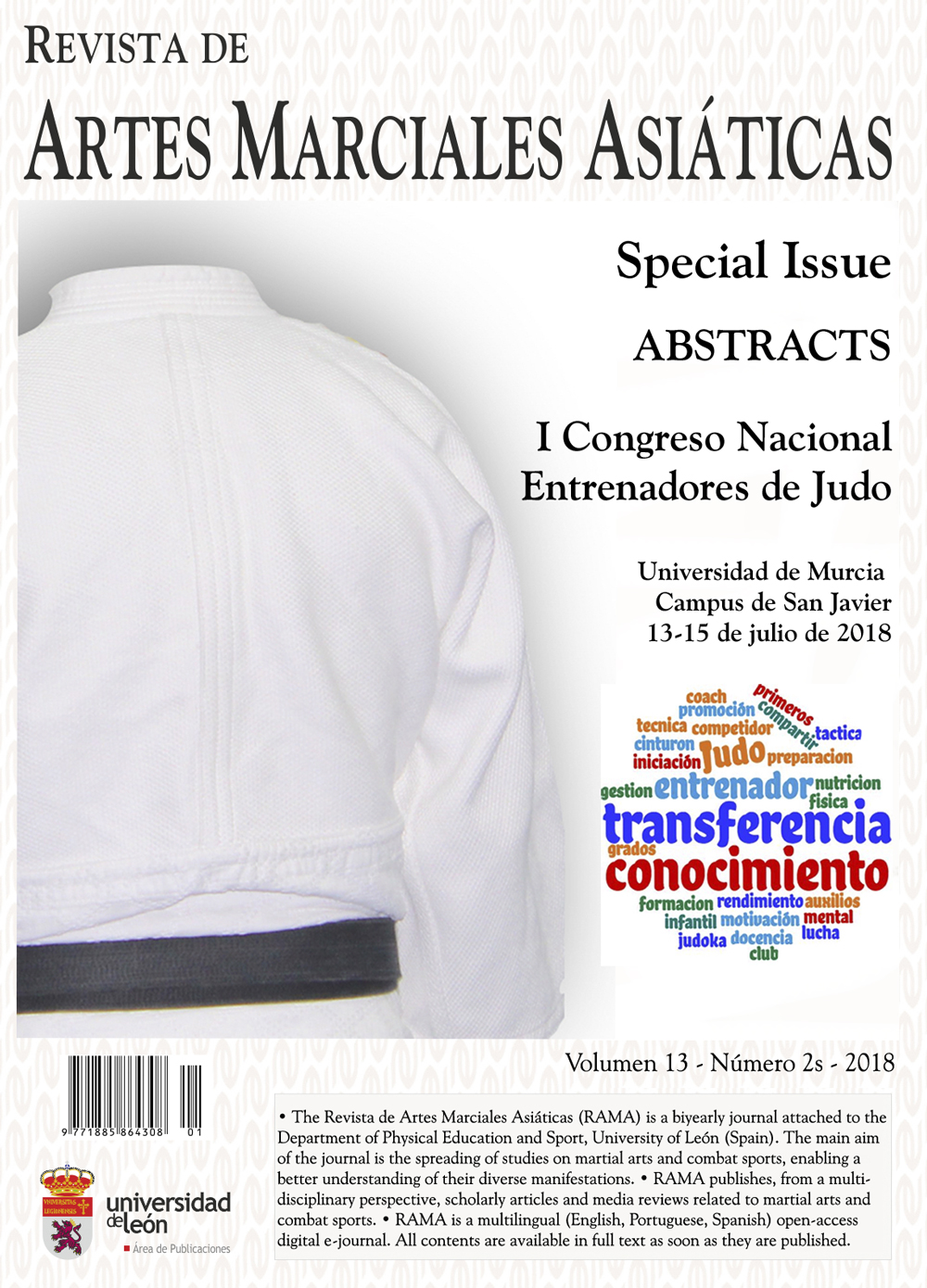Anxiety and coping strategies of judo competitors
DOI:
https://doi.org/10.18002/rama.v13i2s.5501Keywords:
Competitive anxiety, coping strategies, judo, psychological skills, combat sportsAbstract
The aim of this study was to describe the anxiety responses and coping strategies used by competitive judokas of different sex category, level of performance, experience and age category. The sample was composed of 58 competitive Spanish judokas. They completed a battery of test composed by a socio-demographic questionnaire, the CSAI-2R and the ISRA-B, responses version, to evaluate anxiety. Finally, we used the ISCCS to evaluate the judokas’ coping strategies. The results showed that women, low performance judokas, experienced judokas and the top age categories (junior and senior) presented high levels of anxiety and lower auto confidence. Correlational analysis showed that judokas’ most used strategies were task oriented coping (TOC), though with high levels of anxiety they choose emotional oriented coping (EOC), which the scientific literature does not associate with good performance. In addition, high levels of auto confidence correlated positively with distraction-oriented coping (DOC). The practical implication of this work relates to the usefulness of this information for the improvement and optimization of competitive judokas’ copying strategies.
Downloads
Métricas alternativas
References
Andrade, E. M., Arce, C., & Lois, G. (2007). Propiedades psicométricas de la versión española del Inventario de Ansiedad Competitiva CSAI-2R en deportistas. Psicothema, 19(1), 150-155.
Buceta, J.M., Gimeno, F., & Pérez-Llantada, M.C. (2007). Influencia de las variables psicológicas en el deporte de competición: evaluación mediante el cuestionario Características psicológicas relacionadas con el rendimiento deportivo. Psicothema, 19(4), 667-672.
Delgado, J., Márquez, S., Molinero, O., & Salguero, A. (2013). Análisis de las estrategias de afrontamiento en futbolistas de categoría cadete. ef Deportes.com, (181) Revista Digital, Recuperado de http://www.efdeportes.com/efd181/estrategias-de-afrontamiento-en-futbolistas.htm
Geukes, K., Harvey, J. T., Trezise, A., & Mesagno, C. (2017). Personality and performance in real-world competitions: Testing trait activation of fear of negative evaluation, dispositional reinvestment, and athletic identity in the field. Psychology of Sport and Exercise, 30, 101-109. doi: http://doi.org/10.1016/j.psychsport.2017.02.008
Kardum, I., Hudek-Knežević, J., & Krapić, N. (2012). The structure of hardiness, its measurement invariance across gender and relationships with personality traits and mental health outcomes. Psihologijske teme, 21(3), 487-507.
Kumar, A. (2016). A study of pre-competitive anxiety involving male and female players competing in team versus individual events. International Journal of Physical Education, Sports and Health, 3(1), 135-137.
Márquez, S. (2006). Estrategias de afrontamiento del estrés en el ámbito deportivo: fundamentos teóricos e instrumentos de evaluación. International Journal of Clinical and Health Psychology, 6(2), 359-378.
Molinero, O., Salguero, A. y Márquez, S. (2010). Propiedades psicométricas y estructura dimensional de la adaptación española del Cuestionario de Estrategias de Afrontamiento en Competición Deportiva. Psicothema, 22(4), 975-982.
Ruiz, R. (2004). Análisis de las características psicológicas, deportivas y sociales en el deporte del judo a nivel competitivo: Una propuesta teórica y metodológica para la predicción del rendimiento. Tesis Doctoral no publicada. Universidad Autónoma de Madrid, Madrid.
Tobal, J.J., & Cano-Vindel, A.R. (2002). ISRA. Inventario de Situaciones y Respuestas de Ansiedad (5ª Edición). Madrid: TEA Ediciones.
Downloads
Published
How to Cite
Issue
Section
License
Copyright (c) 2018 Sofía Hogrefe, Roberto Ruiz-Barquín, Olga Molinero

This work is licensed under a Creative Commons Attribution-NonCommercial-ShareAlike 4.0 International License.
The authors who publish in this journal must agree to the following terms:
- The authors grant on a nonexclusive basis the exploitation rights (reproduction, distribution, public communication and transformation) of the work accepted for publication to the University of León. The authors can establish, on their own, additional agreements for the non-exclusive distribution of the version of the work published in the journal (for example, placing it in an institutional repository or publishing it in a book), always acknowledging the initial publication in this journal.
- This work is licensed under the Creative Commons Attribution-NonCommercial-ShareAlike 4.0 International License. Click to see basic information and the legal text of the license.
- The authors are allowed and encouraged to disseminate electronically pre-print or post-print versions of their work before publication, as this can give rise to productive exchanges, as well as earlier and increased citing of the works published.











